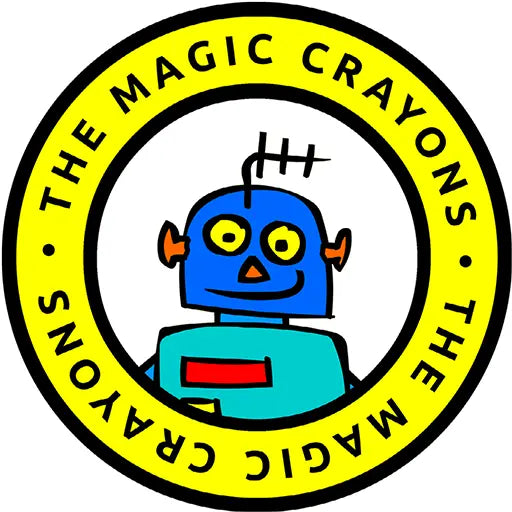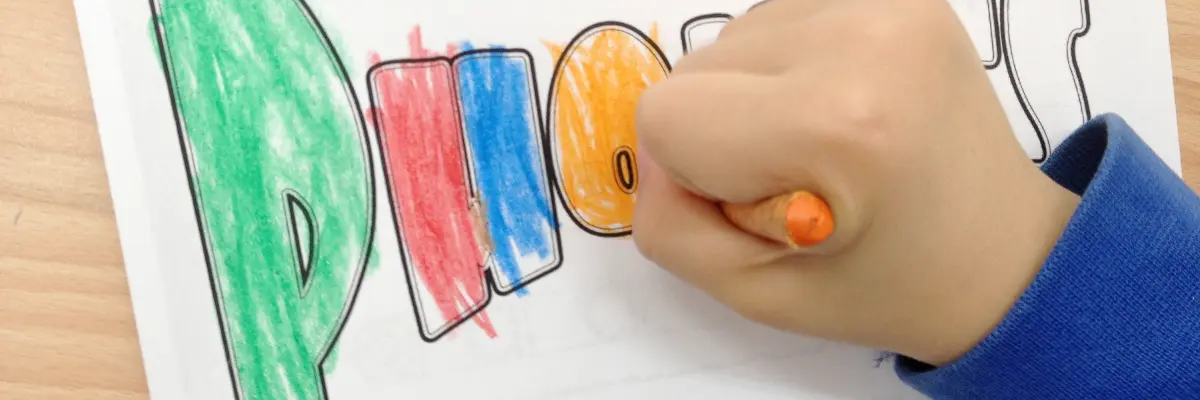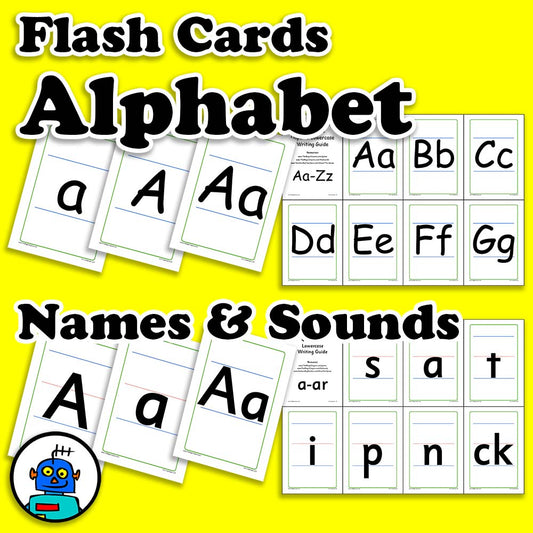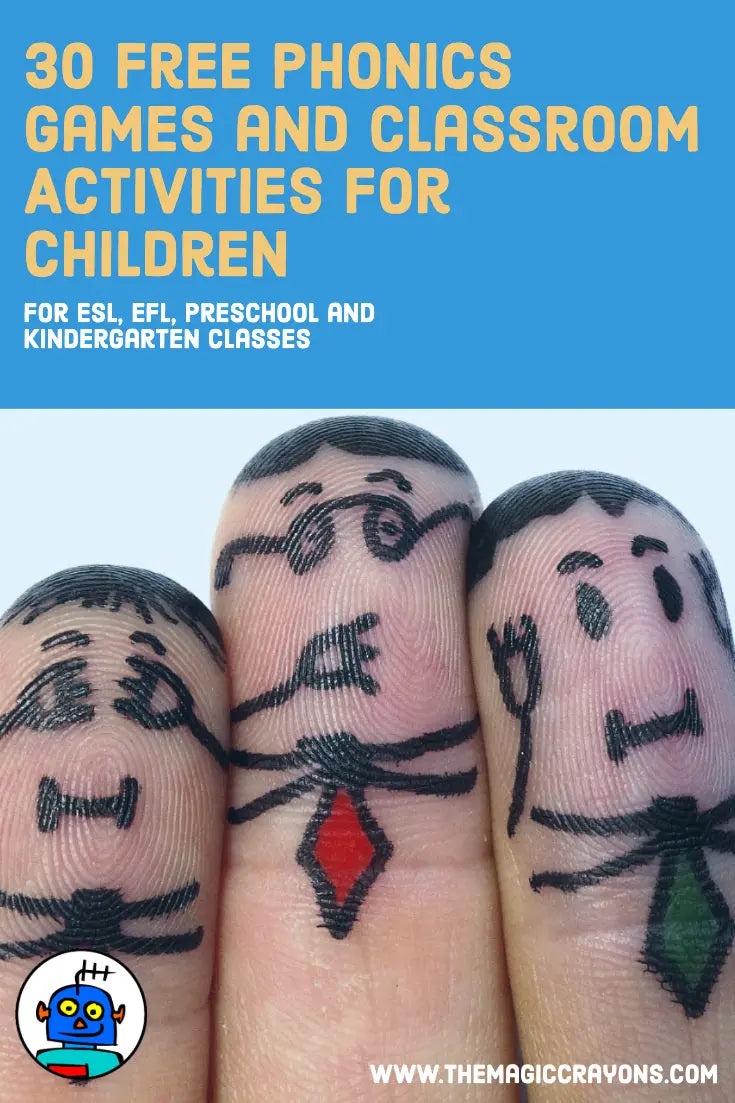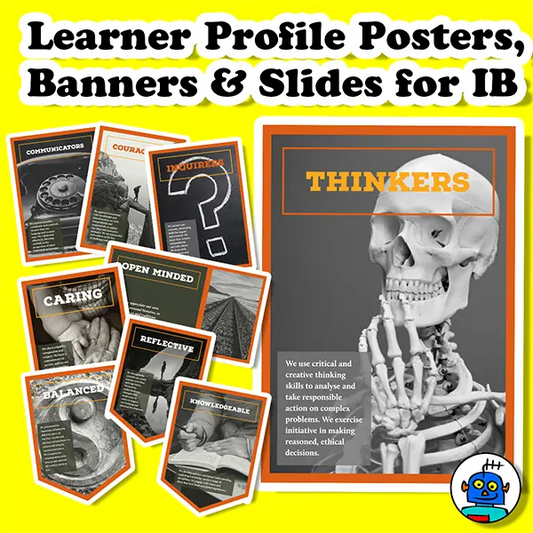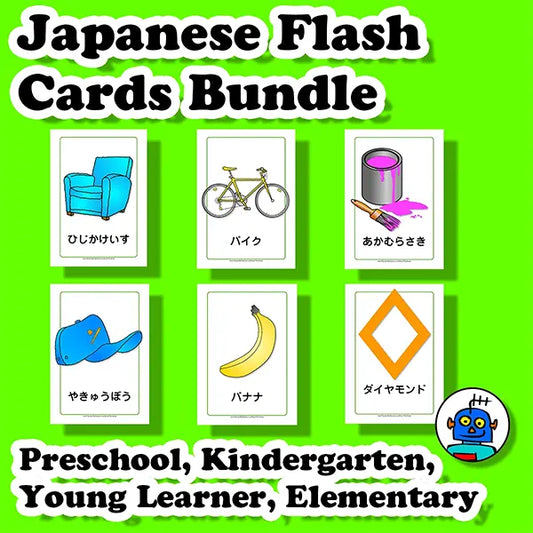Free Phonics Games and Activities for the ESL English Classroom
Fun Phonics Theme Unit Vocabulary for Children in PreSchool, Nursery, Kindergarten, and International School Classrooms. Educational Resources Written, Tried and Tested by English Language Teachers Working With Students in Japan.
© The Magic Crayons
-
1. Snake Game
Resources
How To Play
Board game in the shape of a snake with all the letters of the alphabet in random order.
-
Students advance by throwing a dice. Each time they stop, they have to name the letter they land on and sound it out. For more advanced students, teacher can ask student to name a word beginning with that letter. Like any other board game, it also can include spaces for miss one turn, go back 2 steps, etc.
Phonics Resources
-
English Alphabet Phonics Flash Cards | 16 Sets | Digital Download
Vendor:The Magic CrayonsRegular price $3.00 USDRegular priceUnit price per -
Months Of The Year Classroom Posters In Jolly Phonics Font | Digital Download
Vendor:The Magic CrayonsRegular price $1.00 USDRegular priceUnit price per
-
2. Scrambled Words
-
Students (in groups) have to make as many words as possible in a certain amount of time using only those letters. Give students hints if they are having trouble getting started. For example: with “Christmas Tree” as the long word, teacher can say, “Something you drink.” Answer: tea
-
3. Sticky Fingers
Resources
How To Play
- Each student grabs one of your fingers.
- The target letter is announced (with or without phonic). Then simply start saying words (start with words they already know). If a word starts with the target phonic the children run to the far wall.
- If you manage to tag a child on the way, they are out.
- If a child lets go when a word doesn!t start with the target phonic (e.g. if the target letter is “B” and someone took off running after you said “dinosaur”) then they!re out.
- Rinse and repeat with new phonic.
NOTE: Children don't have to be "out" points can just as easily be used (or not). Also, if the finger holding is weird, simply have students place one hand on one of the room's walls.
-
4. What's Missing?
Resources
How To Play
- Divide class into two teams
- One team (the challenger) chooses 5 letters to present the first member (the guesser) of
the opposing team. The guesser then has 5-10 seconds to memorize the set of letters. - With the guesser!s back turned, the challenger removes one letter and then prompts the
guesser, “OK. What!s missing?” - Points awarded to guesser if s/he is correct, to the challenger if not.
- Teams reverse rolls. Rinse and repeat.
-
5. Showdown i
Resources
How To Play
- Students are split into teams.
- The first student from each team is called forward and they are placed back to back.
- Each is given a flash card bearing a target letter which is held face out against their chest.
- When directed the two take three paces (count together to prevent cheating), turn and ID the card their opponent is holding.
- Fast draw gets a point for his team, or slow draw is out; whatever!s clever.
- If you ALSO require a finger gun and “bang” following the target word, it!s more fun.
Difficulty settings suggestions:
- Nen Sho: As is. Use letter names and anchor words. Ties are resolved through janken.
Nen Chu: Ties are resolved by providing a non-anchor word that starts with the same phonic sound. - Nen Cho: Have students use non-anchor words as their “ammunition.” AND, if they!re up to the challenge, allow the slow draw to counter, after which point the two opponents go back and forth until someone is stumped (i.e. Student 1 has “B” and S2 has “D.” S1 goes first with “dog,” S2 counters with “ball.” Then S1 goes again with “daddy” at which point S2 blows him away with “baby,” and rides his pale horse triumphantly, however slowly, into the setting sun).
-
6. Showdown ii: High Noon
Resources
How To Play
NOTE: requires at least 4 students
- Have the class stand in a circle.
- Each student gets a flashcard and holds it so that everyone can see it (whether the picture side or the letter side is face out is up to you). Before the round officially starts make sure everyone is clear on everyone else!s card.
- You then say the phonic/anchor word of one of the cards.
- The student holding that card ducks, and the students on either side of him/her turn and face each other. The first one to say the phonic/anchor word on their opponent!s card is the winner and stays in.
- The loser looses their card. As they no longer have a card, they duck whenever the person to their left or right ducks.
NOTE: If the last rule is too difficult for younger students, they can simply be "out,! be given a negative point, or be given a new card. With smaller classes you!ll want to keep everyone playing. Also, don!t forget to shuffle students as well as cards so that they!re not always facing the same student/s. Also, once students are familiar with the phonic, don!t feel restricted to just the anchor word. -
7. Splat
Resources
How To Play
NOTE: Requires black/white board. May become a little messy (you!ll see).
- Divide the class into 2 or more teams.
- Write (or have the students write) the target phonics! corresponding letters on the black/ white board.
- Take two balled up tissues and dampen them enough to stick when thrown (if you can get two different colored tissues, that!d be keen).
- Have one student from each team get a snow ball and stand before the board.
- Have one of the other students choose a target letter/phonic and call it out.
- The two students before the board then throw their tissue balls at the corresponding letter.
- The student who!s tissue SPLATS closest to the letter (or closest to the center, if they!ve good aim) earns a point for their team.
- Rinse and repeat.
NOTE: The tissues will obviously erase words written on the board, so feel free to simply tape the FCs to the board. Alternatively, points could be scored by the closest tissue NOT touching the letter, as erasing the letter hurts it. “Awwwww; "E!s hurt. Poor "E.! Are you OK,
"E!?” -
8. Code Breakers
Resources
How To Play
- REALLY good for smaller classes. A bigger class could be split into teams to avoid the game ending in two rounds.
- Write a four letter string (composed of target letters) on a piece of paper. The goal is for students to figure out what you!ve written.
- Give each student a small whiteboard (it helps if you make underscores out of vinyl tape and stick them to the boards as an aid. It ensures a 4 letter string and helps prevent super tiny letters). If the classroom doesn!t have a black/white board, then you!ll need one as well.
- Have the students write a 4 letter string on their whiteboard. When done, go around and have each student read aloud their string.
- As each student reads their string, write it on the classroom board. When they are done erase incorrect letters (accompany with wacky explosion sound, or Conan!s squeaky bike sound as appropriate)
- Have the students try again now that they have clues as to the correct code.
- First to crack the code wins.
-
9. Shooting Gallery, Or Space Invaders 2: Rise Of The Lycans.
Resources
- Alphabet Flash Cards
- Self Adhesive Magnets (Amazon #Ad)
- Bean Bags (Amazon #Ad)
How To Play
NOTE: This requires some prep, but once the prep is done it!s an easy “go to” game, and most of my kids love it (all of my classes are small, and this is a great one on one game). Also, it requires a sort of "hair-trigger! set up (explained below).
Prep: You!ll need to make some kind of fairly large target (8”x8” ish) with a weak-ish magnet affixed to it (imagine one of the FCs with a cheapo flat magnet taped to it!s back so that it could be stuck on a black board). I made cards that look like the aliens from Galaga.You!ll also need two bean bags or two small soft balls (I prefer bean bags).
Last, all of my KGs have towel racks in most of the classrooms that are free standing and steel. This is crucial for the game, but can maybe be improvised (read on for it!s function).
Assuming the above:- (For the sake of clarity, I!ll assume one on one, rather than teams).
- Place towel rack again a flat wall (no lockers, etc. behind it). Stick the space invaders to it and gently wedge a tiny Alpha FC between each one and the rack. On a table at the opposite side of the room place various FCs which begin with the target phonics.
- Give each student a bean bag. When you say, “Ready? Go!” they both toss their bean bags at the towel rack. When a space invader is hit it will fall and drop it!s Alpha FC. If they miss, they simply retrieve their bean bag and try again.
- When a student reveals a FC s/he runs to it, and calls aloud it!s letter name, then runs to table and matches it up with whatever FC starts with its phonic, announcing the phonic and the vocab word. (e.g. “D” is revealed. Student picks it up and shouts “D!” then, at the table, matches it to the dinosaur card and shouts “d, d, dinosaur!”).
- Student then returns to throwing the bean bag at space invaders.
- The game is a race to make the most correct pairs. As the game isn!t turn based, it!s very fast paced, so you will probably have enough time to play twice (the students will surely insist that you do).
-
10. Action Tic Tac Toe (“丸バツゲーム?!”)
Resources
How To Play
- Arrange target FCs in a 3x3 grid on the floor (I also set up a “pitching line” which students must stay behind. This helps prevent nen-chus from stepping on cards, as well as making it more "proper!)
- Students can be divided into teams or play as individuals and take turns pitching a beanbag at the grid
- If whatever card the beanbag lands on is properly identified, it is marked either “O” or “X” accordingly. Three in a row and you win. Ba-doi~
Difficulty settings suggestions:
- Nen Sho: As is. If using the anchor words, try to elicit the phonic sound as well (i.e. “o, o, octopus”)
- Nen Chu:
- Nen Cho: Instead of simply saying the card, pitcher must give a non-anchor word that starts or ends with the target phonic. As it can be a quick game, maybe round one is “words starting with __”, and round two is “words ending with __”. IN ADDITION (optional): If pitcher is unable to think of a word, the opposing side gets a chance to answer. If the opponent is correct, the pitcher!s pitching line is pushed back by one tile (or some other arbitrary measurement).
-
11 Alpha Hopscotch
Resources
Vinyl Floor Tape (Amazon #Ad)
How To Play
Set up a hopscotch course but substitute letters for the numbers.
Note: if you have the time, it!s a good idea to actually draw this out on the floor with vinyl floor tape or something to avoid over ambitious hoppers slipping on the laminated cards.
Difficulty settings suggestions:- Nen Sho: Roll of a pair of dice to determine how many squares the player must hop through. Require them to announce the letter and/or anchor word of squares they land on. Successfully reaching the semicircle results in a point, or being winner of that round.
- Nen Chu: Depending on how bright the class is, either dice or a dumbed down version of proper hopscotch(see below). If they!re already pretty clear on the phonic sound, require non anchor words that start with the target phonic sound (when practical. For vowels, any word containing it!s phonic (a la ST3)).
-
- Nen Cho: Proper hopscotch rules (see below), but in the interest of time, perhaps any successful run up and down the course produces a "house!. Require non-anchor words that either start or end with the target phonic (or for vowels, words that simply contains that short vowel. i.e. “cat” for “A”).
Proper hopscotch rules - First player tosses a beanbag on the first square
- They then hop over that square the second square and continue down the course. Upon reaching the semicircle, player turns around and comes back, picking up beanbag along the way.
- If all first player is successful, they continue by throwing the beanbag into the second square, this time hoping over that square. If first player is unsuccessful the next player starts where they left off. (note: should the player tossing the bean bag miss the correct square, they lose their turn.
- First player to finish the entire sequence of squares turns her back to the course and tosses the beanbag over her shoulder. Whatever square it lands in becomes her "house! and from then on only she is aloud to step on that square.
- Nen Cho: Proper hopscotch rules (see below), but in the interest of time, perhaps any successful run up and down the course produces a "house!. Require non-anchor words that either start or end with the target phonic (or for vowels, words that simply contains that short vowel. i.e. “cat” for “A”).
-
12. Battleship
Resources
How To Play
- Note: battleship with more than two players ends up being a kind of reverse bingo, which takes some of the competitive edge out of it, just fyi.
- prep: printouts with two 5x5 grids on them (I like taped off whiteboards with flat magnet "ships.! Feels more "gamey!) Unless you fear a time crunch, there!s no need to assign the rows and columns- have the students do that as practice (although maybe keep the vowels together for re-enforcement).
- Woo!! SINK that ship!!
-
13. Bingo
Resources
- Alphabet Flash Cards
- Alphabet Bingo (Amazon #Ad)
How To Play
- Prep: Either make a few random bingo sheets to print out and bring to class or use baords from the alphabet bing game, or have students fill out grids at home to play next class (if you!ve tried to have kids do this on the spot you know why).
- If you don!t need to swing the game in favor of the loser kid and want it to be truly left to chance, a box with a whole on the top makes it a lot more fun for everyone.
- If Box: Take turns with the students drawing and announcing cards (or, if you!re super cool, ping pong balls)
- Keep in mind you can set up bingo like a battle ship grid, so instead of calling out “E!” you!re calling out “E-B.”
Difficulty settings suggestions:
- Nen Sho
- Nen Chu
- Nen Cho: Attaining “bingo” ends the game and earns 2 points. At this point all students are given a minute or two to make words using the letters that have been ticked off on their game sheets (boggle style). Each correct word earns 1 point, so even if you didn!t get "bingo! you can still win.
-
14. Go Fish
Resources
How To Play
- Prep: depending on the number of students/teams playing, any number of pairs of target letters/anchor word cards.
- Deal each player 5 cards.
- Player to the left of the dealer starts (or let janken decide) and asks any other player “name, do you have a __,” or, “name, please give me __.”
- If the player being asked has the card in question, it is relinquished to the asker. If not, he replies with a hardy, “go fish!” or “Aarrrrgh, go fish!” at which point the asker draws a card from the undealt stock.
- If the card drawn is the card that was asked for, player gets to go again. If not, the player still keeps it, but it is the next player!s turn.
- The aim is to make as may pairs as possible. When a pair is created, it leaves a player!s hand and is placed face up on the table before him.
- The game continues until a player empties his hand, or the stock is exhausted.
Difficulty settings suggestions: - Nen Sho: As is.
- Nen Chu: Use upper and lower case letters.
- Nen Cho: Use upper and lower case letters. When game is over give bonus points if players can spell words with their cards. OR (if your class is bright and really likes card games) simply play some sort of phonic Gin Rummy with alpha cards and instead of making runs and sets, require the players to make words (will require extra vowel cards). Perhaps more realistic for ni-nensei…
-
15. Letter Puzzles
Resources
- Alphabet Flash Cards
- Patterned Origami Paper (Amazon #Ad)
How To Play
- Get the students to help you write the target letters on sheets of paper-origami size is good, and the different colors will help out younger students a lot- one set of letters (upper and lower case) per sheet.
- Cut the sheets of paper into simple-ish puzzles.
- Mix up all the pieces, and have the students race to put them back together.
- Elicit the phonics from the students once puzzles are complete (if students are
particularly slow, try setting a time limit). Maybe completing a puzzle is worth 1 point, and you can earn extra points by providing the letter name and phonic sound/anchor word.
Difficulty settings suggestions:
- Nen Sho: as written above. If students are at all competent at drawing, maybe draw quick pictures of the anchor words (all of the vowels have fairly easy to draw anchor words, after all)
- Nen Chu: If far enough in the year/term, try using simple [3 letter] words rather than upper/lower case letter combos. If students are having trouble sounding out words, try playing with “word families” (a simple and familiar set of words like “cat” “bat” and “hat”). Have students pronounce phonics individually while assembling puzzles to encourage sounding out words.
- Nen Cho: Again, use words. Break out the “magic e” and elicit two readings from each puzzle (i.e. “hat” and “hate”).
-
16. Labyrinth
Resources
How To Play
- Depending on the amount of prep you feel up to, there are two approaches you can take.
1) use tape and FCs to map out a course on the ground a la the phonics mazes in the activity book.
2) make a maze out of classroom tables and chairs and place face down flash cards throughout. - Basic game focuses on one phonic. As the activity referred to above, paths marked by words starting with the target phonic sound are traversable, the others are not.
- Get to the goal.
Difficulty settings suggestions: - Nen Sho:
- Nen Chu: Have the students go through the maze by themselves, but have them make a map. When all students have completed have them check each other!s maps (out loud).
- Nen Cho:
- Depending on the amount of prep you feel up to, there are two approaches you can take.
-
17. One Piece
Resources
How To Play
- Prep: Hint cards detailing item/card locations. Also, cards should be hidden throughout the classroom (or outside, if you can manage. What an adventure!!) before class. Map (optional). Kind of time consuming for a phonic game, but, if it!s done right, it!ll probably be worth it.
- Explain that you!ve found a hint to the location of Gol D. Roger!s legendary “one piece” (or whatever, although I!m fairly certain any reference to “one eyed willie” will be lost)
- Your quest starts with a simple hint card (map optional): something like a picture of a piano, or a quarter note to indicate that the next hint is around the piano.
- Remember, your clues don!t all have to be gimmies. It!s ok if you have to read the clue cards as long as you use words they know so they can help with the treasure hunt. If a clue says “I live outside, I!m white, have long ears and I like carrots. I!m the gatekeeper, are you the keymaster?” they!ll understand outside, white, ears and carrots, so the next clue is obviously somewhere around Mimi-chan the school!s rabbit.
- Some (or all) hint cards are accompanied by a letter card. When all letters are collected it spells the final hint, where the one piece is hidden (smelly sock, anyone?)
Difficulty settings suggestions:
- Nen Sho: Keep the hints simple so you!re not completely running the show. Also, try and make sure they!re able to sound out most of the final clue with no help.
- Nen Chu: Try dumbed down ichi-nensei rules. If you!re left doing most of the work,
- Nen Sho: Try words instead of pictures on the hint cards. Also, try placing the letter cards out of order, so they have to unscramble the word (straining to read nonsense words gives them hints and is HILarious, apparently). Also, false leads can test their vocabulary.
-
18. Darumansan Ga Eigo Wo Hanashita!
Resources
How To Play
- Note: “darumasan ga koronda” is basically Japanese “red light, green light” with subtle changes. If you!re unfamiliar with it, it has a wikipedia page
- Hopefully students are familiar with the original Japanese game. Explain to them that in this variation the oni must say “darumasan said __,” where is any letter of their choosing as long as its phonic is being covered that day. (feel free to replace “darumasan” with “sensei” or whoever)
- After the oni has spoken the key phrase and turns the other players must freeze and say a word starting with that letter!s phonic.
- If a player answers incorrectly (or takes an excessive amount of time) they must join the oni, take a step back, or return to the starting line; whatever!s clever.
- For maximum effect encourage poses when freezing, and have rounds where students must hop or move like certain animals rather than simply running to the oni.
Difficulty settings suggestions:
- Nen Sho: Make sure you!re the oni for a while at first. Allow students to overuse the anchor word in their responses, but be sure to cycle through several phonic when you prompt “darumasan said __”
- Nen Chu: encourage students as oni. Use of non-anchor words earns the player an extra step towards the oni.
- Nen Cho: Cho rules are fine.
-
19. Hangman
Resources
How To Play
- You all know this game.
- While some students just seem to "get! phonics, others can seem hopelessly lost, so be sure to keep the categories simple (YES: “animals,” NO: “"80s one hit wonders”).
- Help out by sounding out any correctly guessed letters, etc.
Difficulty settings suggestions: - Nen Sho: I wouldn!t even think of trying to play this with nen-chus …
- Nen Chu: If you really feel you can try this with your chos remember to keep the words very short (“cat,” “dog,” stuff like that). Also, try giving free letters (for example, they should be familiar with words like “rock” and “sock” but learning the rule for “-ck” is a couple years off, so make the “c” a freebie). Also, try under scoring vowels a different color
- Nen Cho: Again, keep the words short. Also, to ensure students have any chance at winning, try sticking to words they!ve worked with in LSP, as well as letting them reference their books while playing.
-
20. Short Vowel Bull
Resources
How To Play
- Materials needed: several sets of vowel cards,
- Rules are similar to the card game “bull****.”
- Deal out all cards (face down)
- Dealer (you) says a target word containing a short vowel. Either anchor words, or one syllable words whose nucleus contains a short vowel (e.g. “cat”) are fine, but be sure to stick to one type per round, to minimize confusion.
- The first player identifies the vowel used (e.g. “A”), takes all “A” cards from his hand and places them face down on the table in what becomes the community stack declaring the number of cards while doing so (e.g. “Four "As!.”)
-
- Before the dealer says the next word, should the next player doubt that the first player has played the cards specified (perhaps P1 played 3 "As! and an "E,! or all "Es! for that matter), he has the option to challenge. Also, if the next player thinks the wrong vowel was identified (e.g. four "As! declared and played in response to the word “dog”), then, again, he can challenge. This is done by yelling “bull” (or some other word).
- Should the cards be contested, they are turned over and checked. If P1 did in fact play what he said he played, and identified the correct vowel, P2 must collect all the cards in the community stack. If P1 was fibbing, or identified the incorrect vowel, he must collect all the cards.
- First player to empty his hand wins.
-
21. Modified Bocce
Resources
- Alphabet Flash Cards
- Stress Balls (Amazon #Ad)
How To Play
Prep: You!ll need a few sets of balls (roughly tennis ball sized) to play this (3 bass per player/team) and unless you play outside, you!ll want some sort of sheet to lay on the ground to provide friction. Some Daisos have sheets of felt that would work nicely.
- Divide the class into teams where appropriate (bocce is best with 4 players with 2 balls apiece, but whatever)
- Draw a series of concentric circles on the felt. Each circle represents a target phonic.
- A random player throws the pallino (a smaller ball that serves as the target) into the game field. The same player also throws the first ball.
- Players must ID the ring their balls fall within (by letter, phonic, etc) or forfeit their next turn. (maybe be a good idea to have phonic for “out of bounds” as well)
- Player who manages to get closest to the pallino wins.
- Note for those unfamiliar with bocce: it!s totally cool to knock other players balls (and the pallino) out of the way with your own. It!s the best part of the game, actually.
-
22. Rhyming Bull
Resources
How To Play
- Materials needed: alpha flash cards (although scrabble tiles would be awesome for mahjong-esk tile-slamming action).
- First player (you) starts with a word [that you feel the students can rhyme]. Note: when setting cards/tiles leave a space between the starting phonic and the end sound (i.e. “H_AT”)
- Next player replaces the starting phonic (depending on level, encourage consonant blends) and reads new word
- Before player changes phonic, however, he can challenge the previous player as to the validity of the last word created by shouting “BULL!!”(or “BALOGNA!” or “LIAR!” or “BUU- BUU!!” or whatever)
- Dictionary (READ: you) decides if challenged word is, indeed, a word (if feasible, explain what word means). If not, player who made the word is out (or receives a demerit or whatever)
-
23. Shiritori
Resources
How To Play
- Like the Japanese game [players must say words that start with the last kana of the previous word]
- In place of kana, start and end sound is used
- As it is purely a phonics exercise, words that end in silent E should be followed by the consonant that precedes E (e.g. “cape”! “page”).
- Also, if the wrong letter is used, but the correct phonic is being used, let it slide (e.g. C K and Q all make the [k] sound. C also makes S!s [s] sound. Soft G and J both make the [d#] sound)
-
24. Baseball
Resources
How To Play
- If the class is large enough, divide into teams. Very small classes should play as one team (against you).
- Loosely set up classroom as a baseball diamond (move tables and chairs out of the way and set clearly defined bases)
- First student steps up to the plate. You, as the “pitcher,” wind up and reveal a letter.
- Student has to the count of three to produce a word starting with that letter. If student fails to do so, the result is a “strike” and you “throw” a new letter at them (three strikes and your out, obviously). Should the student produce an acceptable word, however, s/he advances to first base.
- You obviously get where it goes from there. Kids who like to play teacher should get a kick out of pitching to you. As a team you only get one strike and one out.
- Alternatives (or “come on, sensei! That was a double!”):
- For students with a larger vocabulary, bases earned is determined by the number of correct words they can produce within the 3 second count.
- To avoid dirty, lying ghost runners set up some arbitrary way of determining bases earned (e.g. roll a die and the number of bases you advance = |x-2| , where x=2 is an infield fly; tough noogies Haruki.)
-
25. Classic Concentration
Resources
How To Play
Prep: Prepare Master image (game is fairly quick, so prepare a couple)
Materials: F/Cs (to hide the main image), blackboard & magnets (optional)- Basically, like the old game show Classic Concentration (or Catchphrase), except “matching” isn!t necessary to clear portions of the hidden image, and the rebuses are replaced with a single picture.
- Before the lesson (or during, if you trust students won!t peek), affix the master image to the blackboard and cover with a 3x3 or 4x4 grid of cards (hold the cards in place with magnets).
- Note: The cards can either be face down and used purely to provide cover for the picture underneath, or you can use alpha F/Cs (face up) which can function as cover as well as the question prompt.
- Class is divided into teams where appropriate.
- First team must answer a letter/phonic/anchor word question. If they are correct a card is removed from the black board (not allowing students to choose which card will likely allow you to stretch out the game a little more) revealing the master image underneath.
- The team then has until the count of three to guess the master image (only the first guess is accepted). If they guess correctly, they win. If not, it is the other team!s turn.
- Note about the master image: When preparing the hidden picture keep in mind the size of the cards that will cover it and make the image large enough to allow proper coverage. Try to keep the image very simple so ensure several cards must be removed to identify it. Also, keep the image relevant; perhaps an anchor word for one of the phonics being covered.
Difficulty settings suggestions:
To increase difficulty, require more selective answers and/or increase grid size. -
26. Blockbusters
Resources
How To Play
Materials needed: Alphabet Flash Cards, origami to serve as markers for captured blocks
- Not unlike the old game show Blockbusters.
- Divide class into two teams
- Set up flash cards in manner similar to the Blockbusters game
board (see below), but, contrary to the game show!s layout, make the number of columns equal to the number rows. Also since the flash cards are not hexagons, simply offset every other column by half the length of a card. - (using the board to the right as an example) one team is white, and the other is blue. White team goes first and selects “I.” The clue might be “What "I! word is a cold house” or “what "I! word is the opposite of outside?” (assuming your kids know the word "opposite.!
“Not outside, but …” might be a more appropriate clue). - First team to raise a hand gets the first chance to answer. If they are correct the block turns their team!s color, if they answered incorrectly the other team has a chance to answer.
- First team to create a path from one side to the other by answering correctly, wins.
- Remember to keep clues VERY simple.
Difficulty settings suggestions:
- Nen Sho: instead of lettered blocks, use numbers. Questions are simply random letters for which an anchor word must be answered.
- Nen Chu: Depending on ability of the class, either nen-chu or ichi-nensei rules.
- Nen Cho: As written above.
Nen Sho:年中. Nen Chu:年長. Nen Cho:一年
-
27. Phonics Line
Resources
How To Play
Materials: flashcards
Time: 6-10 minutes
Receptive Language: instructions, various
Productive Language: various
Game Explanation: Two teams standing in straight lines. The first student in each team approaches the instructor to receive a question (‘What letter is it?’, ‘What’s the first letter in ____?’, ‘What sound does this letter make?’, etc), returns to her team, asks the next student in line the same question, & returns to the instructor with the answer. If the answer is correct, the first student goes to the end of her team’s line & sits down, while the second student approaches the instructor for a new question; if the answer is incorrect, she must return to her team & ask the third student the same question, & so on.
Note: -
28. Make-A-Sentence
Resources
How To Play
Teacher makes a number of small-sized noun and preposition word cards before class. Students randomly choose two noun cards and one preposition card and create a simple sentence. Students then take turns reading their sentence to the class. Because the cards are chosen randomly, students usually end up with nonsensical and funny short sentences, for example, “(The) lion (is) in (the) frog.”
Teacher adds the determiners and the “to be” verbs while the students read the sentences. Eventually the students will become used to saying them. The game can be made more difficult by adding in verb cards, number cards, colour cards, and/or other adjective cards.
-
29. The Tissue Game
Resources
- Alphabet Flash Cards
- Box Of Tissues (Amazon #Ad)
How To Play
Learning: Listening, speaking and reading activity game using the Jolly Phonics Sounds. Great for introduction, practice and review.
Ages: 5-10
Write various phonics sounds on the white board at student height. Twice. Have the class or individual students say clearly each sound. Choose sounds from your current book and/or previous books for review. As a guide, if I have a class of six students, I would write up 8 pairs of sounds.
Seat the students in a line a distance away from the board or to one side. The writing should be big enough for all students to see. -
Issue each child with one tissue. In later games a child can be made responsible for this.
The first pair of students stands. The teacher says a /sound/ and the two student’s race to the board to erase one sound each, then race back to their allocated seat.
Praise as you see fit for speed, accuracy, and behavior.
After a few plays ask a well behaved child to call out a /sound/ rather than yourself.
Ensure all children have an equal amount of attempts.
I have found this game to be very popular, so I limit its use so they do not become tired of it.
-
30 Scrambled Words
Resources
How To Play
Use alphabet cards to spell out a long word. Students (in groups) have to make as many words as possible in a certain amount of time using only those letters. Give students hints if they are having trouble getting started. For example: with “Christmas Tree” as the long word, teacher can say, “Something you drink.” Answer: tea
-
31. Wacky Word Pairs
Resources
How To Play
Have a stack of random adjective cards on the table. Each student starts with a basic noun card (flower, car, etc.) and take turns choosing the adjectives they want to describe their noun. Students continue until all adjectives have been used and funny combinations have been made.
-
32. Alphabet Dive
Resources
How To Play
Have a stack of random adjective cards on the table. Each student starts with a basic noun card (flower, car, etc.) and take turns choosing the adjectives they want to describe their noun. Students continue until all adjectives have been used and funny combinations have been made.
Like it? Share it!
Popular Resources
-
IB Learner Profile Posters and Banners - Design and Computing Set | Digital Download
Vendor:The Magic CrayonsRegular price $5.00 USDRegular priceUnit price per -
IB Learner Profile Posters and Banners | Digital Download
Vendor:The Magic CrayonsRegular price $5.00 USDRegular priceUnit price per -
IB Learner Attributes Posters Slides - Animals Theme | Digital Download
Vendor:The Magic CrayonsRegular price $4.00 USDRegular priceUnit price per -
Japanese Flash Cards Bundle | Digital Download
Vendor:The Magic CrayonsRegular price $13.00 USDRegular priceUnit price per$26.00 USDSale price $13.00 USDSale -
English Alphabet Phonics Flash Cards | 16 Sets | Digital Download
Vendor:The Magic CrayonsRegular price $3.00 USDRegular priceUnit price per
